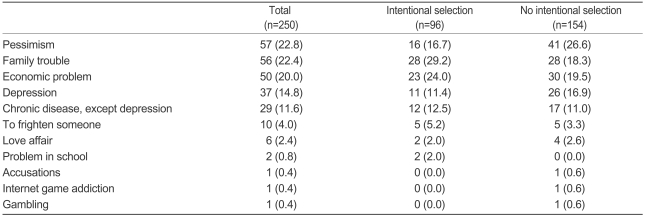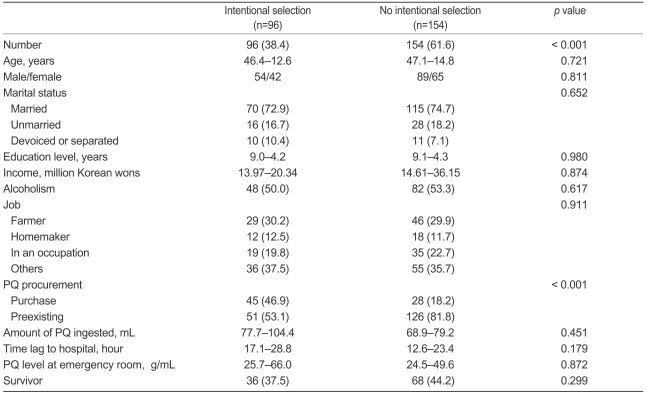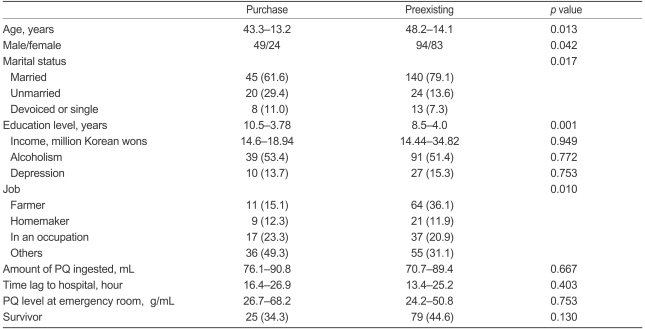Paraquat Intoxication in Subjects Who Attempt Suicide: Why They Chose Paraquat
Article information
Abstract
Background/Aims
Paraquat (PQ) has been used in suicide attempts; an estimated 2,000 toxic ingestions occur annually, with 60-70% mortality. We sought to determine why PQ is such a common agent for suicide attempts in Korea.
Methods
We analyzed 250 cases (143 males, 107 females) of attempted suicide by PQ ingestion from January to December 2007. The procurement of the PQ was divided into two categories: purchased and preexisting.
Results
Men were more likely to have purchased PQ than women (66% vs. 22%, p=0.042). Additionally, men were more likely to be unmarried (n=34, 23.9% vs. n=10, 9.3%) or divorced or separated (n=16, 11.3% vs. n=5, 4.6%) than the women (p<0.001). The group who intentionally selected PQ (38.4%) consisted of 96 cases (54 males, 42 females) and the group who did not intentionally select PQ (61.6%) included 154 cases (89 males, 65 females). The incidence of PQ purchase was higher in the intentional selection PQ group (46.9% vs. 18.2%, p<0.01).
Conclusions
Only 38% of patients who attempted suicide with PQ intentionally selected PQ. Thus, greater control of PQ availability is needed, especially in patients at risk.
INTRODUCTION
In Korea, approximately 85% of acute toxic pesticide ingestion is due to suicide attempts [1]. Paraquat (PQ) (1,1-dimethyl-4-4-bipyridium dichloride; gramoxon), is an herbicide that is commonly used for suicide attempts. PQ has been used for the past three decades in Korea, with an estimated 2,000 toxic ingestions annually and an associated 60-70% mortality [2]. Worldwide, PQ accounts for 20 deaths per million persons. Much lower rates have been reported in developed countries, such as Japan (11.0 per million persons), Ireland (2.7 per million persons), Great Britain (0.66 per million persons), and the United States (0.004 per million persons [3]).
Over the past 30 years, several methods have been studied for modifying the toxicity of PQ, including prevention of absorption from the gastrointestinal tract [4,5], removal from the bloodstream [6,7], prevention of accumulation in the lungs [8,9], scavenging oxygen free radicals [10,11], and the prevention of lung fibrosis [12,13]. However, these methods have not proven to be effective. Patient outcome is usually determined by the degree of exposure to PQ.
Thus, improved prevention of acute PQ intoxication appears to be the only method to reduce the number of toxic exposures. The purpose of this study was to determine whether we could identify specific factors associated with PQ use for suicide attempts in Korea.
METHODS
This study analyzed 250 cases (143 males, 107 females) of attempted suicide with PQ ingestion. The patients were admitted to the Institute of Pesticide Poisoning (IPP), Soonchunhyang University Cheonan Hospital, from January through December 2007. We evaluated their medical records retrospectively to determine the reasons for the use of PQ. Additionally, we assessed how the PQ was obtained. Patients were included if they had a positive PQ urine test and completed a questionnaire. Patients who were discharged from the emergency room or who could not complete the questionnaire were excluded.
The medical records included details of present illness, personal history, family history, and disease history. Demographic variables, such as age, gender, marital status, address, and occupation, were collected for analysis. The exposure to PQ was assessed by the amount reported to have been ingested and urine PQ testing. The time interval between ingestion and arrival at the IPP was assessed. Marital status was classified as married, unmarried, and divorced or separated. Education level was defined as the sum of elementary school (6 years), middle school (3 years), high school (3 years), college (2-4 years), and postgraduate education (2-4 years). Job status was classified into four groups: farmer, homemaker, unemployed, and other. Alcoholism was defined as drinking to a drunken state more than once a week on a regular basis and for longer than the last six months.
The intentional selection group was defined by the answer to the question, "Did you select PQ after considering other pesticides?" Additionally, the means of obtaining the PQ was divided into two categories: purchased (situations in which patients bought a new bottle of PQ) and preexisting (wherein patients already had PQ available).
Reasons for the suicide attempts were classified into 11 categories: pessimism, family trouble, economic problems, depression, chronic disease (excluding depression), to frighten someone, love affairs, problems in school, accusations, internet game addiction, and gambling.
The amount of PQ ingested was determined by the reported mouthfuls ingested (one mouthful was calculated as 20 mL); in Korea, most PQ products are in a 23% solution. The PQ concentration in plasma was measured by HPLC in the emergency room.
Statistical analysis
The data analysis included distribution of values, expressed as mean and standard deviation for numerical data and proportions for nominal data. A value of p<0.05 was deemed to be statistically significant. Differences in covariates between subgroups were tested by t-tests and chi-squared tests.
RESULTS
The mean (±SD) age of the subjects was 46.8±14.0 years. The amount of PQ ingested was 72.28±89.64 mL (range, 1.0-500.0). The PQ concentration was 24.92±56.42 µg/mL (range, 0.00-487.00). The marital status of the subjects was as follows: 74.0% were married (n=185), 17.6% were unmarried (n=44), and 8.4% were divorced or separated (n=21). Employment status included 75 farmers (30%), 30 homemakers (12.0%), 54 people unemployed (21.6%), and 91 classified as other (36.4%). Alcoholism was identified in 91 subjects (55.8%). Ninety-six patients chose PQ intentionally (38.4%).
Reasons for the suicide attempt were pessimism (57 cases), family trouble (56 cases), economic problems (50 cases), depression (37 cases), chronic disease excluding depression (29 cases), to frighten someone (10 cases), love affairs (6 cases), problems in school (2 cases), accusations (1 case), internet game addiction (1 case), and gambling (1 case). Thirty-three patients had prior histories of suicide attempts.
Significantly more men than women were unmarried (n=34, 23.9% vs. n=10, 9.3%) and divorced or separated (n=16, 11.3% vs. n=5, 4.6%, p<0.001).
The intentional selection group included 96 cases (38.4%, 54 males, 42 females) and the non-intentional selection group of 154 cases (61.6%, 89 males, 65 females). The amount of PQ ingested, time interval from ingestion to presenting at the hospital, PQ level in the emergency room, and survival rate showed no difference between the intentional and non-intentional groups. However, the frequency of "purchase" was higher in the intentional selection group (46.9% vs. 18.2%, p<0.001, Table 1). No difference was found in the reasons by age, gender, marital status, education level, income, incidence of alcoholism and depression, job status, or etiology between the intentional and non-intentional selection groups (Table 1 and 2). Fourteen patients in the intentional selection group and 19 patients in the non-intentional selection group had prior histories of suicide attempts (12.3% vs. 14.6%, p=0.831).

Comparison of the etiology of suicide, between subgroups, with and without an apparent attempt to select PQ
The means of obtaining the PQ was divided into two categories: purchased (n=73, 29.2%) and preexisting (n=177, 70.8%). Men were more likely to have purchased new PQ for the suicide attempt than were women (66% vs. 22%, p=0.042, Table 3). Additionally, the age was younger (43.3±13.2 vs. 48.2±14.1 years, p=0.013) and the education level higher (10.5±3.7 vs. 8.5±4.0 years, p=0.001) in the purchase group than in the preexisting group. Farmers were more likely to be in the preexisting than in the purchase group (36.1% vs. 15.1%, p=0.010). No significant difference was found in the incidence of alcoholism or depression between the purchase group and the preexisting group. The amount of PQ ingested, time lag to the hospital, and plasma PQ levels in the emergency room were not significantly different between these groups (Table 3).
DISCUSSION
The underlying causes, incidence, and methods of suicide attempts vary with cultural, social, and economic conditions. Although no precise statistical data are available, PQ is frequently used in suicide attempts in Korea [2]. In 2007, 469 patients who attempted suicide after swallowing a pesticide were admitted to our hospital (unpublished data); PQ accounted for 301 (64.2%) of those cases. The 250 cases reported here is the largest one-years experience reported by any hospital, to our knowledge. To identify reasons why these patients ingested PQ in suicide attempts, we carefully reviewed the information in their medical records.
The precise etiology of the suicide attempt was not the focus of this study. However, pessimism, family troubles, economic problems, and depression were the major identified causes of the suicide attempts, in that order. Clearly, many of these categories overlap; for example, an economic problem can lead to family trouble and pessimism, and depression was associated with many of the suicide attempts.
We sorted the patients into two groups, the intentional and non-intentional selection groups, to determine whether the patients had specific information about PQ, such the lack of an effective therapy and the consequent high mortality rate. The intentional selection group accounted for 38.4% of cases. This result suggests that almost two of every three patients ingested PQ simply because it was available when they attempted suicide. Some of the patients bought an herbicide from a shop without mention of a specific trade name and it simply turned out to be PQ.
No significant differences were found in the cause of the suicide attempt, age, gender, marital status, education level, income, incidence of alcoholism or depression, or job status between the intentional and non-intentional selection groups. However, men were more likely to purchase new PQ than women (66% vs. 22%, p=0.042). Additionally, the education level was higher in the purchase group than in the preexisting PQ group. Among all subjects, 30% (75 of 250 cases) were farmers and 85.3% of these patients had preexisting PQ in their living environment.
In conclusion, only 38% of the patients who attempted suicide with PQ actually intentionally chose PQ. Thus, it is important to decrease the accessibility of PQ to improve suicide prevention. In particular, control of the storage of pesticides on farms and control of the purchase of pesticides by farmers would be helpful.

